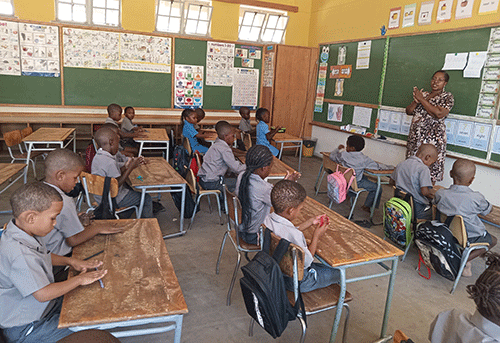KEETMANSHOOP – With the commencement of the 2023 academic year, government primary schools in the //Kharas region are facing challenges with the provision of space for learners, inadequate classroom furniture and waiting for stationery from government.
When New Era visited some schools late last week, principals and teachers were strategising on shortcomings that hinder quality education.
Metumo Aupokolo, principal of Krönlein Primary School, said he has 44 learners more than last year, meaning some grade four teachers have to accommodate up to 45 learners per classroom.
“This is not an ideal situation, as it will become extremely difficult for a teacher to give all his learners equal attention,” he said.
Aupokolo also said they are using double desks to fit two learners per desk, where only 20 such desks can be placed in a classroom – but with classes having more than 40 learners, it becomes an uphill battle.
While the principal also wants to accommodate those learners on waiting lists, he cannot, as there is a lack of furniture.
“At this stage, we are still waiting for stationery from government but I am urging parents to buy at least the basic stationery items like pens, pencils and notebooks,” he said.
Aupokolo furthermore assured that no child will be turned away for not having stationery. Meanwhile, Anna Vries, St Matthias Primary School’s principal, said she is expecting 863 learners by the end of the 15th school day, who must be accommodated in 25 classrooms, with an average ratio of 36 learners per teacher.
“The main reason for this influx of new learners is that of parents being transferred or coming here in search of employment with their children not placed at schools,” she reasoned.
She said another obstacle is that parents put children on various waiting lists, further complicating the placement process.
Vries also said pre-primary (grade zero) and grade one learners make up the bulk of her school’s waiting list.
“The challenge is that pre-primary learners from other schools are now looking for space but, unfortunately, we have our own grade zero learners to accommodate,” she explained.
She called on parents to enroll their children in June the previous year when the process started, instead of waiting for schools to open in January.
Magrietha van der Brooks, principal of Kaitsi!gubeb Combined School in the remote Berseba village, said 14 out of 35 grade nine learners were not promoted last year to grade 10, while the school received 20 new grade zero learners so far.
“Although the hostel has a capacity to accommodate 144 children, the reality is that we cannot take in so many lodgers, as we do not have enough beds and mattresses, pending provision from the regional office,” she explained.
Van der Brooks said all learners from nearby farms are accommodated, making up the total of 99 lodgers in the hostel.
She also said 316 learners are currently benefitting from the school feeding programme, and parents are also donating cooking oil and sugar to the kitchen.
“Our school did also not yet receive stationery from government, while our textbooks are not enough for learners, and they are not in a good condition,” she listed as some of the challenges they are facing.


